NASL football league looks to kick on in North America
- Published
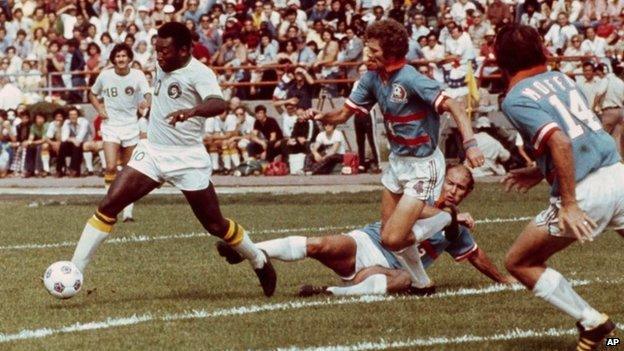
Pele on his debut for the New York Cosmos in 1975
Forty years ago this summer Brazilian football star Pele made his debut for the North American Soccer League (NASL) team, the New York Cosmos, as the US looked to embrace the global phenomenon of football.
Ten years later, in 1985, the NASL imploded, and the game limped on in indoor arenas before the founding of Major League Soccer (MLS) in 1993.
Most football fans are aware of the MLS, helped by the importation of ageing stars such as Steven Gerrard, Didier Drogba and David Beckham, but many will be unaware that the NASL brand name has also returned.
According to the US Soccer Federation (USSF), the NASL sits below the MLS as the official Division 2, but as NASL commissioner Bill Peterson tells the BBC website, "we certainly don't see ourselves as a second-status league".
Indeed, the NASL has major club expansion and commercial plans in the pipeline.
'Big opportunity'
Founded in 2009, the league is a totally different business from its predecessor, although it has taken responsibility for sustaining the memory of the NASL's "Golden Era", external from 1975 to 1984.
"There is a big opportunity right now for football here in the US," says ex-NFL Europe and AEG executive Mr Peterson. "There have been major changes over the past decade.
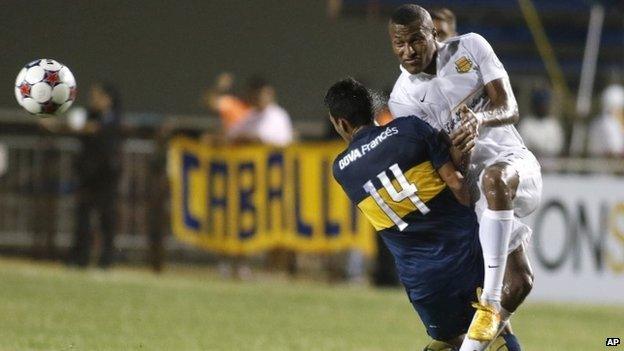
The NASL hopes football fans will enjoy following both foreign and US home-based teams
"Going into the 1980s you had millions of kids who played the sport, but there was not a chance for them to connect with clubs. Now they can connect to clubs, albeit often through TV, and often to overseas teams."
The broadcasting of overseas football, including England's Premier League, had created a new, soccer-savvy US supporter, he says.
"Our task now is not about teaching them, it is about getting them to follow our teams."
League expansion
Familiar names in the league are the re-founded New York Cosmos, Fort Lauderdale Strikers and Tampa Bay Rowdies, which all take their names from famous 1970s NASL clubs.
The NASL plans to expand from its current 11 teams (9 in the US and 2 in Canada) to 13 in 2016 - with clubs in Miami and Puerto Rico joining - and then to 15 or 17 in 2017.
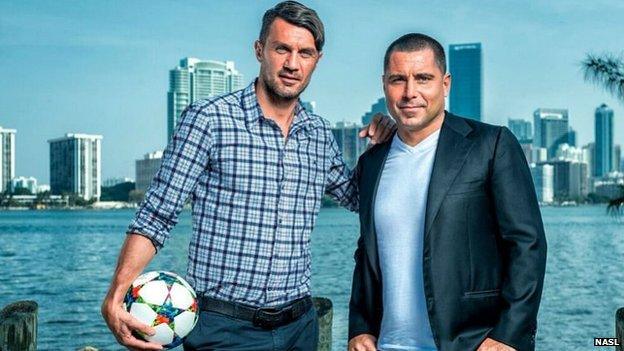
Former Milan star Paolo Maldini and entrepreneur Riccardo Silva are NASL club owners in Miami
The Miami franchise has been secured by former AC Milan and Italy star Paolo Maldini. Other big names participating in the league include ex-Brazil World Cup winner Ronaldo - a minority owner at Fort Lauderdale Strikers - while one time Real Madrid and Spain star Raul is playing for New York Cosmos.
So although it seems the NASL is also looking to ageing stars, Mr Peterson says that "our teams have focused on finding world-class experience at both the ownership and player level", and big names who "understand what it takes to be successful".
The NASL is de-centralised, with each individual investor owning their club, and free to determine its own budget, player roster, wages and stadium provision.
Entry cost
Mr Peterson says that on national TV deals, sponsorship, and licensing deals, NASL clubs will work together, "so that the whole is much more than the sum of the parts".
He also says the cost of joining the NASL is less expensive than MLS membership.
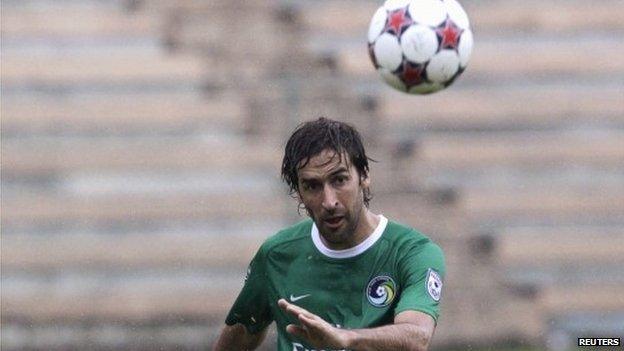
Ex-Spain and Real Madrid striker Raul is now playing for New York Cosmos in the NASL
For example, Manchester City and the New York Yankees reportedly paid $100m (£64m) for an MLS New York franchise, whereas entry to the NASL involves a seven-figure sum.
"Our entry price is different for each club," says Mr Peterson. "Our philosophy is not to try and take money at the front end from potential owners.
"We have an admission fee, in single-digit dollar millions."
He says potential owners have to be "trustworthy people with a sufficient net worth", and able to deal with any financial challenges that may emerge.
'Natural evolution'
Owners are also expected to take the initiative in forging connections with local government, businesses, and the wider community in their home cities.
Meanwhile, clubs should "not spend more money than they make".

Mr Peterson is seeking a title sponsor for the NASL
In the past, the NASL has stepped in to help those in financial difficulty, such as the Atlanta Silverbacks, but Mr Peterson says they do not envisage doing so again.
The expansion programme has also given the league what Mr Peterson says is enough critical mass to look towards securing a main presenting sponsor, and other NASL sponsor partnerships.
"With expansion to 13 clubs we felt the time was right to look for a number of sponsor deals that will benefit the whole league."
In March the NASL announced an expansion of its relationship with ESPN, external for the current 2015 season, with a minimum of 120 league matches streamed live via ESPN3 in 75 different countries.
Why relegation doesn't exist in US soccer
Despite a spike in football interest after the Fifa men's and women's World Cups in 2014 and 2015, there is still massive room for growth in football TV viewing in the US.
"This is our fifth year, and our clubs are performing at a high level," he says.
"In addition, we have invested in TV production, so we are in a position to have legitimate conversations with broadcasters now."
Urban v suburban
At present six of the 11 current NASL club grounds only hold 10,000 or less fans, while many are not soccer-specific arenas.
But Mr Peterson says the days when US civic authorities and taxpayers could be cajoled into funding new $1bn (£640m) sports stadiums have gone.

Tampa Bay Rowdies are upgrading the Al Lang Stadium to nearly treble its capacity
"That is one of the reasons why we don't require clubs to build new stadiums," he says.
"Most of our clubs however are in conversations about either building a new one, or revamping existing ones, such as in Tampa Bay and Fort Lauderdale.
"It takes a lot of work to build new stadiums. We would like stadiums in urban areas rather in the suburbs, but land is expensive and not easy to find in the urban areas."
Promotion and relegation
On the playing side he advocates that European-style promotion and relegation to and from the MLS should be introduced. This does not exist at present, with movement between the leagues being determined by other factors.
For example Minnesota United FC is transferring from the NASL to the MLS in 2018, after the latter identified the club as a good fit for its own expansion plans.
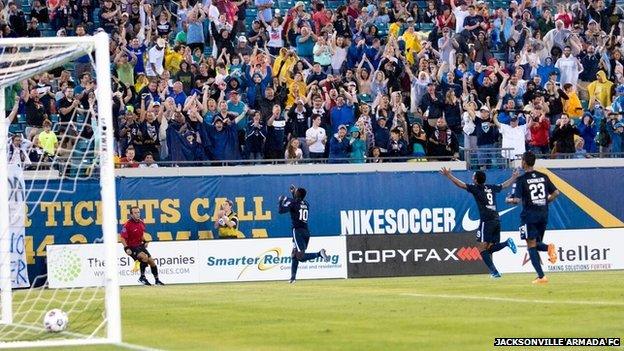
The NASL has a focus on expanding football in Florida
"We would be all for promotion and relegation, and this is something I want to talk to the USSF about," says Mr Peterson. "Every amateur team needs to have the dream of going up the football pyramid."
Another challenge is establishing a competitive structure across such a large geographical area.
"That is why we have gone for four teams in Florida, which has a population bigger than some countries," says Mr Peterson, "we will do something similar on the West Coast, and then look to fill in [in between]."
Meanwhile, Mr Peterson is aware of the the "Golden Era" history his league is following.
"We feel we are the custodians of that time now," he says. "We have taken it upon ourselves to tell the stories, of who was involved., external It is an important part of US soccer history."